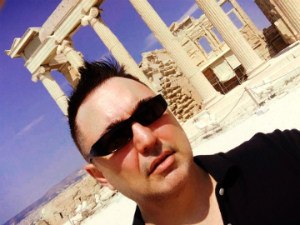In The Powerful Presence Of The Maiden Goddess
 Many centuries have come and gone since the Athenians ascended the Acropolis to seek the guidance and protection of Athena, the maiden goddess of wisdom, war and divine intelligence. Her status as the favorite daughter of Zeus, and powerful patron deity of the city of Athens, remains evident to this day.
Many centuries have come and gone since the Athenians ascended the Acropolis to seek the guidance and protection of Athena, the maiden goddess of wisdom, war and divine intelligence. Her status as the favorite daughter of Zeus, and powerful patron deity of the city of Athens, remains evident to this day.
Expecting to be mostly drawn to the Theatre of Dionysus Eleuthereus, when I visited the Acropolis of Athens in Greece*, I was instead keenly aware of the omnipresence of Athena’s legacy. My undergraduate education in literature and drama afforded me a reasonably good understanding of the role of the god Dionysus in ancient Greek culture. I knew about the festivals and plays, and as a student I often imagined visiting the remains of those historic open-air auditoriums.
A sacred landscape is not simply a backdrop for action, but rather a place filled with names, associations and memories that link together everything present there. Humans become linked to the rocks, trees, animals, rivers, mountains and these bonds guide future human interaction with that place ~ Christopher Tilley
But when my friend Sandra and I reached the Theatre of Dionysus, I did not hear the echoes of the choruses of long-forgotten Greek tragedies, or the murmur of the 17,000 spectators who came to see them lament. Instead I heard the resounding, reassuring voice of Athena only – a goddess I never paid much attention to before. She called to me very clearly, inviting me higher up to her sanctuary.
Pagan tradition has it that places and objects are charged with magical, transformative energy through focused ritual, belief, thought and prayer. This ancient sacred energy bestowed upon Athena by so many devotees is vividly palpable on the Acropolis. This sacred historical site remains imbued with her electric strength, her infinite wisdom and her feminine charm. The prayers and offerings of every man, woman and child who over the centuries reached out to her for guidance and protection are still whispered by the winds around the marble columns. Her name is perceptibly hummed by the birds in the olive trees on the way up the steep slope.
Millions of feet have made this trek up to the architectural marvels awaiting on top of the Acropolis. One can feel its power underfoot. Expecting to encounter Athena at her most famous and impressive temple, the Parthenon, I was once again surprised to hear her voice coming from the more humble Erechtheion. This temple on the northern side of the Acropolis was dedicated to both Athena and Poseidon, the god of the ocean, earth-quakes and horses.
When ancient Greeks had a thought, it occurred to them as a god or goddess giving an order. Apollo was telling them to be brave. Athena was telling them to fall in love. Now people hear a commercial for sour cream potato chips and rush out to buy, but now they call this free will. At least the ancient Greeks were being honest ~ Chuck Palahniuk
Poseidon competed in a contest with Athena for the position as patron and protector of the city of Athens below. But the people chose Athena, because she created the first olive tree as a gift to the Athenians. Poseidon gave them a spring, but it ran salt water and it was of no use to them. According to an archeologist we spoke to at the Acropolis Museum, there are various myths about what exactly happened at that contest. One version has it that Poseidon neglected to bring a witness to his miracle of bringing forth water from the mountain, so nobody believed he was responsible. Another version has it that the people were asked to vote. All the women then voted for Athena, and since there were more women than men… Athena won by a landslide!
A visit to the new Acropolis Museum is highly recommended when you visit Athens and the Acropolis. Athena’s presence is also very much dominant here and I especially appreciated the close-up view of the original Koira (maidens) from the Erechtheion. Statues of Athena are everywhere in the museum in various shapes and sizes. Many of them reminded me of the Virgin Mary. One cannot help but notice the similarities in her depiction, right down to her headdress resembling a halo.
Articles in this series are from Anthon’s travel blog, which he wrote during his 2013 European tour. The blogs are a collection of spiritual adventures, pilgrimages to sacred places and accounts of his personal odyssey into self-realization. Other articles in this series:
Journey Born Under A Divine Star
A Sign From Apollo At The Delphic Oracle (Dephi, Greece)
The Shaman’s Schmetterling In Gottsdorf (Berlin, Germany)
Empath Unplugged At Bath Spa (Bath, United Kingdom)
From The Inner Circle At Stonehenge (Amesbury, United Kingdom)
The Disappointed Jesus In London (London, United Kingdom)
© 2013 Anthon St Maarten
|
|

Leave a Reply